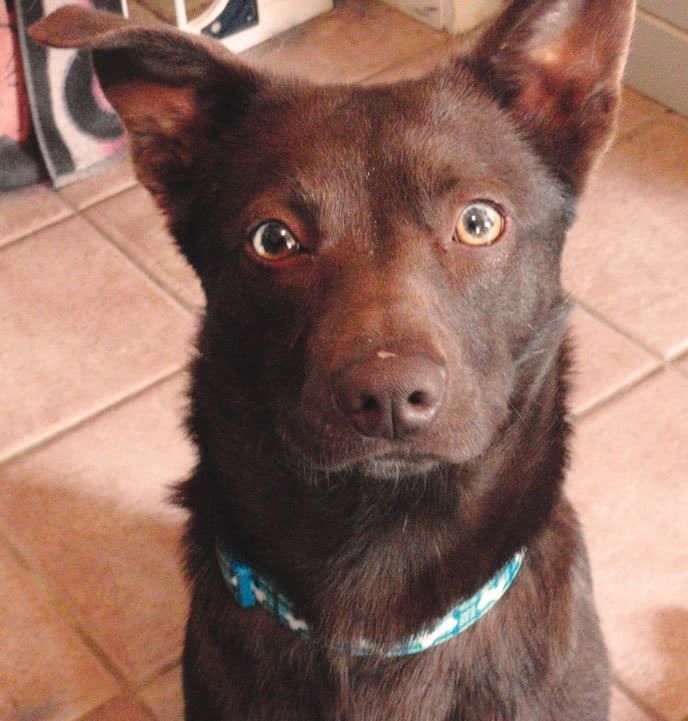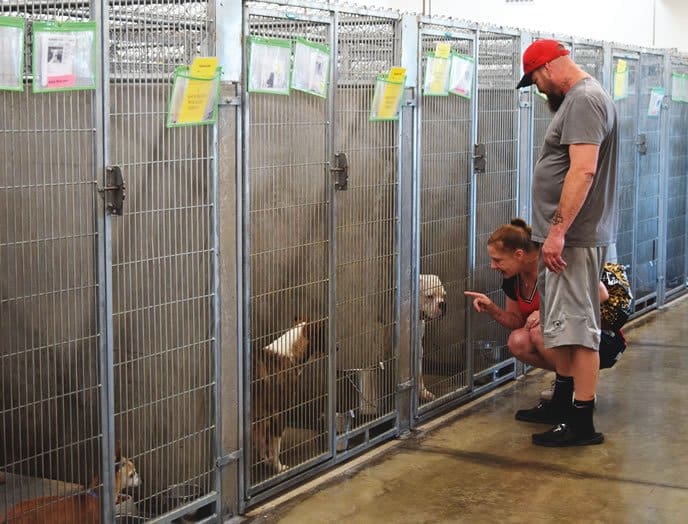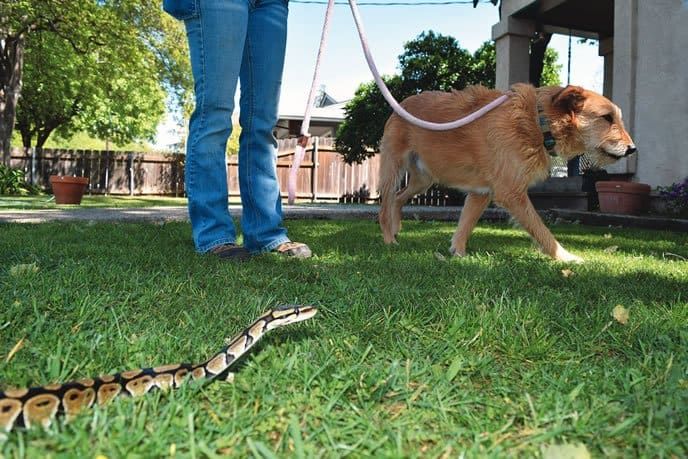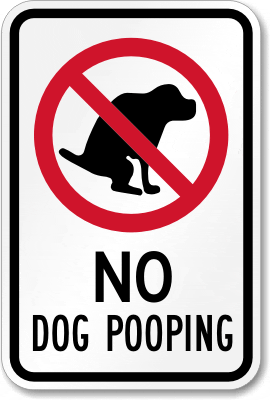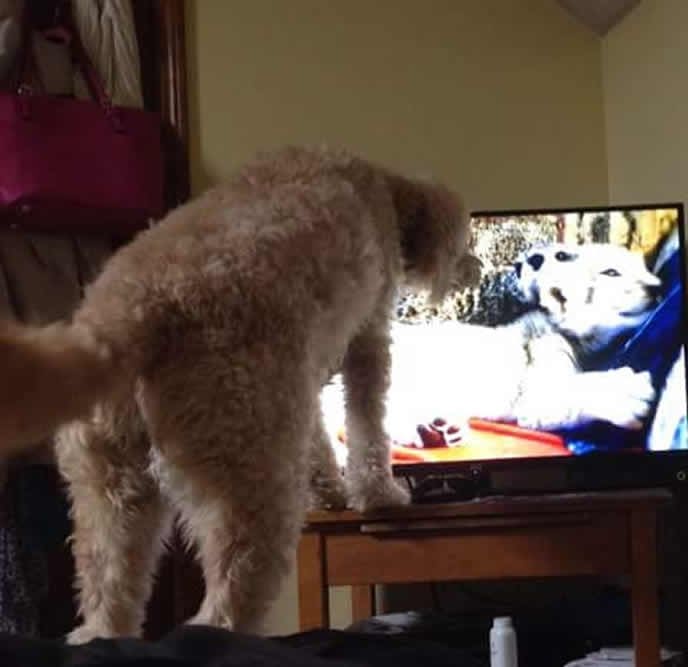[Updated May 23, 2018]
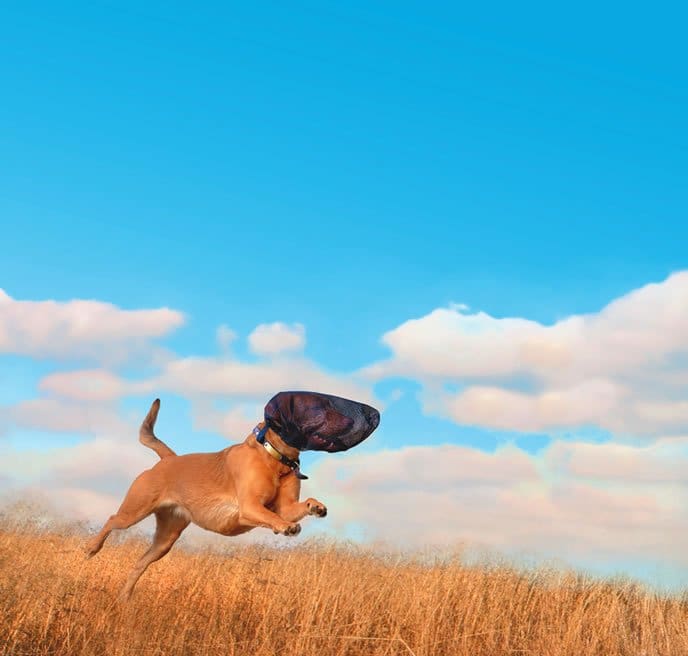
It sounds like a promising pitch for a horror movie: An invader slips surreptitiously into your dog’s body, unseen and unsuspected. While your dog sniffs and snoozes and goes about her everyday life, the intruder burrows ever inward, literally pulling itself through her soft tissue and organs with sharp, needle-like spikes.
But the cunning interloper isn’t an alien, or a zombie virus, or any manner of blob-like mutant. It’s the seed of an innocent-looking grass called a foxtail.
Annual plants that are ubiquitous in the western United States, foxtails can be found bobbing in the breeze along roadsides and hiking trails, and in abandoned lots and suburban backyards. But this enterprising weed has expanded its range widely, and now is found in all but seven southeastern and Gulf Coast states: Florida, Georgia, Hawaii, Louisiana, North Carolina, South Carolina, and Virginia. It has also naturalized through most of Canada and parts of Mexico.
When foxtails flower, they unfurl soft and brush-like spikes that resemble the tail of the crafty canid that gives them their name. Shooting up in waves of green during the relatively moist winter season, foxtails begin to dry out in spring, starting around late March on the West Coast. That’s when the trouble begins, and it persists until rain arrives in the late fall.
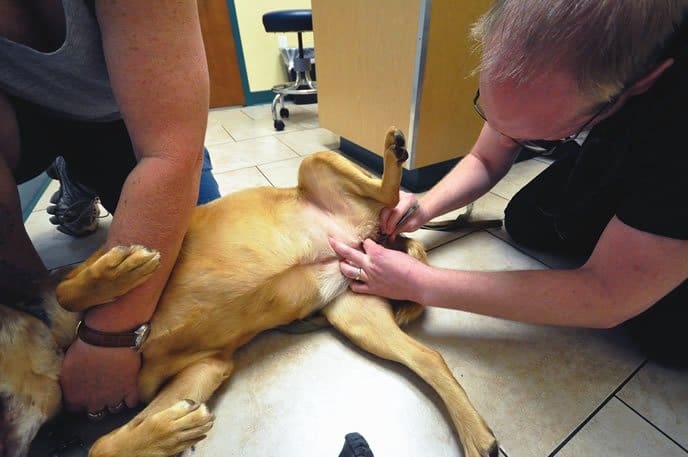
“When the seed heads become brittle and dry, they are treacherous,” says Beth Boynton, DVM, FNAP, professor at the College of Veterinary Medicine at Western University of Health Sciences in Pomona, California. “They have a very sharp and persistent front point, like an arrowhead, and nasty backward spikes that keep the awn moving forward. That’s good for burrowing into the ground – and digging deep into animals’ skin, eyes, nose, mouth, ears, genitals, and feet.”
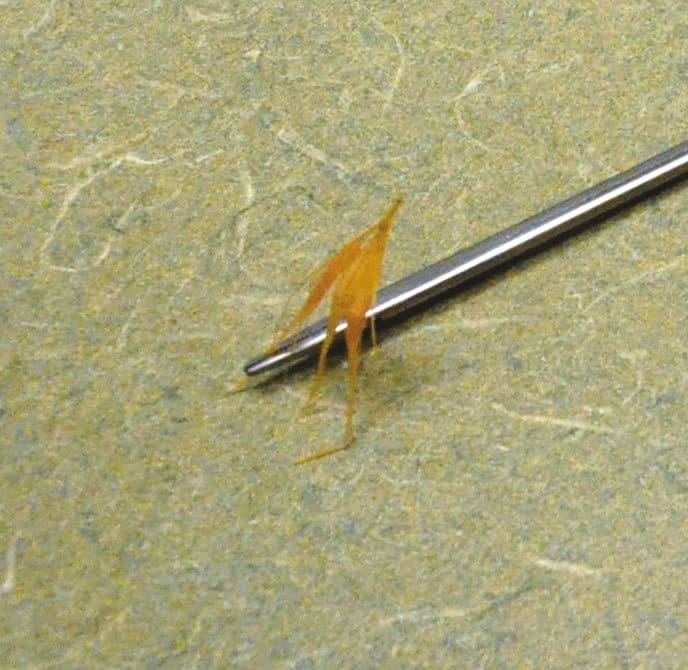
The most common foxtail-producing grass is “wild barley,” (Hordeum murinum). But ripgut grass, cheatgrass, and red brome also produce penetrating seed awns.
California is a hotbed of foxtail activity, and the state’s ongoing drought has expanded the season, as seed heads dry out ever earlier in springtime. “With our warmer and drier forecasts, we can expect to see plenty of these plants,” Dr. Boynton says. “When we have times of economic stress, many lots and yards are left untended and can be sources of foxtail awns.”
True Foxtail Horror Stories
Burrs usually attach to a dog’s fur when they are rubbed against or sat on. In contrast, foxtails are uncannily stealthy, and begin to penetrate with unbelievable speed. Dr. Boynton says the feet, armpits, nose, eyes, and ears are the most common areas where foxtails begin to burrow. Even the simple act of sniffing – an imperative with most dogs – opens the door to trouble. “If the dog is following a scent, they tend to inhale foxtails or get them around the face,” she says.
Nature has designed foxtails to be brutally efficient: They have a sharp point at one end and microscopic barbs that help them “hook” into the soil. Once they find their way into a dog’s body, the barbs move ever forward, nudged on by the movement of muscle (or, depending on where the foxtail is lodged, air flow). Similar to the way a fishhook works, foxtails cannot reverse direction. Behind them, they leave a telltale hollow trail, or tract, which invariably becomes infected.
Foxtails are incredibly resilient, and take a very long time to break down in the body. Left untreated, the infection worsens. And in rare cases, if the foxtail has penetrated the body cavity through the chest or abdomen, it can be fatal.
“Foxtails have been seen to migrate from paws up the leg, into the chest, and deep in the ears or nose,” Dr. Boynton says. “There are reports of dogs having foxtails that burrowed into the lungs, abdomen, or brain.”
Frustratingly, foxtails cannot be seen on X-ray, leaving veterinarians to guess at the cause of a dog’s unexplained infection. Locating the troublesome awn is akin to finding that proverbial needle in a haystack.
Kate Gordon Zimmer of San Diego dealt with foxtails “on and off” throughout the life of her chocolate Labrador Retriever Levi, who died in 2013 at 13½ years old. Zimmer liked to take Levi hiking in the nearby canyons, and she always did a thorough body check after they returned home. But the foxtails were just too sneaky.
“Levi got foxtails in his eye, and up his nose, and, most significantly, in his mouth,” Zimmer says. It was that last point of entry that caused the most trouble – and it happened to Levi twice.
“When the foxtails went into his mouth, he did not inhale them; they worked their way between his teeth and the gum,” Zimmer explains, adding that some dogs like to nibble on newly sprouted foxtails, and, like Levi, can inadvertently ingest them when they are starting to dry out. “And then, they worked their way out – through his cheek.”
Levi’s face ballooned with a lump the size of a baseball. The vet prescribed antibiotics, and the swelling was lanced and drained, but the foxtail was nowhere to be found. “I was given bottles of saline with a hooked tip, and I had to flush the open wound on his face several times each day,” Zimmer remembers. “He was on antibiotics, but nothing was changing, and the wound wasn’t getting any better.”
Finally, the mass on Levi’s face swelled shut, and Zimmer took him back to the vet. As the vet tech led him away, the infected area “exploded” – a moment Zimmer says she’ll never forget. As she and the vet tech cleaned out the wound, they finally found the foxtail.
When Levi repeated that episode a few years later, Zimmer at least was prepared. “That time the issue wasn’t quite as dramatic, and after the initial swelling the foxtail had worked itself through, and we were able to find and extract it,” she says. “But he still had to be on antibiotics and have the wound flushed.”
Vanessa Lawrence of Paso Robles, California, says her four Rhodesian Ridgebacks like to “graze” in the backyard. Even though she is careful to mow down the foxtails as soon as they pop up, she has had a half-dozen or so vet visits in the last few years when foxtails lodged in her dogs’ throats or tonsils. (Foxtails that reach the stomach are often safely expelled from the body.)
If foxtails are problematic for relatively wash-and-wear dogs such as Labradors and Ridgebacks, owners with long-coated breeds face even bigger hurdles. Steve Lausmann of Citrus Heights, California, has Bearded Collies, whose long coats are magnets for foxtails.
“I herd with one of my dogs, and some of the fields have foxtails,” he says. “I spend time immediately afterward to comb and brush out the foxtails. Sometimes this takes hours.”
Despite his diligence, Lausmann has had two large, foxtail-related vet bills – more than $500 each. “Both were in the feet and had become infected,” he says. “And this was after we had gone over the paws thoroughly for foxtails.”
Foxtails are nimble foes, blown about by wind and cropping up where you might least expect them.
“Last weekend, I took two of our Bearded Collies to run in an open field of green grass,” he says, adding that he didn’t think foxtails would be a problem there. But he was wrong. “When I got home and examined them, the foxtails were all over their legs and paws. It took two hours to go over both dogs with combs to remove them.”
The only foolproof way to truly keep a dog foxtail free in an area where the awns are present is to simply not visit there – and even then, you can’t be sure your dog won’t be exposed. But since keeping dogs under glass is not practical, here are some tips for minimizing foxtail infections:
Keep a wide berth. “Keep your dog on leash and away from grassy areas,” Dr. Boynton advises, adding that whenever possible, choose walks with wide paths that minimize contact with the plants. While beaches are generally free of foxtails, trails leading to them often are not.
Consider a “foxtail cut.” Dogs with longer coats can be trimmed so that they are less likely to pick up foxtails – and so it’s easier for you to spot them. In particular, removing hair from the paw area is important, since the space between the toes is a favorite spot for foxtails to migrate. The same goes for around the ears.
Do a post-walk inspection. Dr. Boynton suggests you look and feel thoroughly between all the toes, under the “armpit,” and under and around the tail. Thoroughly check the ears and eyes.
licking, sneezing, or head-shaking? Get thee and thy dog to a veterinarian, ASAP. Excessive licking of a foot or other area, vigorous head shaking, or sudden bouts of violent sneezing are all reasons to bring your dog in for a vet check. In most cases, you won’t be able to see any trace of the grass awn; your vet will likely have to sedate or completely anesthetize your dog in order to explore his ear, nose, or other affected body part deeply enough to find a foxtail. Usually, an otoscope (to view inside the dog’s nose or ear) and long, slender forceps are needed to follow a foxtail’s distinctive tract and remove the awn.
Stop foxtails at their source. Like all weeds, foxtails can spring up seemingly overnight, and diligence is required to keep them at bay. “Encourage neighborhoods and cities to mow, rake, and manage yards and empty lots,” says Dr. Boynton, who reminds that just cutting them down isn’t enough. “The area needs to be raked and cleared. Remember that even with the utmost caution, foxtail awns can blow almost anywhere.”
Beware of composting. Foxtails will survive in the average residential compost heap; the temperature simply does not get high enough to kill them. Instead, place debris in “green bins” to be composted by municipalities, whose composting facilities have the high temperatures that can zap them.
Consider timing. Zimmer tries to visit foxtail-prone areas in the early mornings. “At least here near the coast, there is some coastal fog,” she says. “That makes the foxtails damp, and they don’t break off or get sniffed up as easily.”
Foxtail Head Protection
There is at least one product on the market that helps combat foxtails before they can get lodged in a dog’s body.
Diane Kostelec first heard of foxtails in 1978, when she moved to California and her then-boyfriend with a Labrador Retriever mentioned them. But it wasn’t until she got her own dogs that foxtails really hit her radar screen.
Kostelec’s energetic Vizsla kept having foxtail encounters during their hikes in the San Francisco Bay area. In 2010, she began selling and marketing her OutFox Field Guard , a black mesh hood that attaches to a dog’s collar and covers and protects the entire head.
Kostelec chose black netting because it interferes least with the dog’s field of vision, while also serving as a sunscreen, and the guard is generously sized so it does not touch the dog’s face. When Kostelec first tested it on her own dog, Iris, the Vizsla was unfazed, running around as if nothing was out of the ordinary, even drinking water through the netting. Passersby, however, are a different story. “Some people call it a beekeeper’s hat; other people compare it to a veil. And some figure it’s a muzzle and that your dog is dangerous,” Kostelec says of the varied reactions to the guard. “But once they know it’s for foxtails, people totally get it.”
Kostelec says that she has gotten orders from as far away as Australia. And some buyers who don’t have foxtail problems have found that the devices work well in preventing dogs from ingesting things they aren’t supposed to, from rocks, to acorns, to feces.
The OutFox prevents foxtails from attaching to only the head area. Kostelec says she is contemplating the design and production of a lightweight bodysuit.
Until then, owners who want to enjoy the great outdoors with their dogs need to be aware that in many, if not most parts of the country, foxtails are a very real danger. Try to keep your dogs away from them, and check them frequently for any sign that they may have a foxtail lodged inside them. If you see such a sign, get them to a vet as quickly as possible.
Denise Flaim of Revodana Ridgebacks in Long Island, New York, shares her home with three Ridgebacks, 11-year-old triplets, and a very patient husband.


